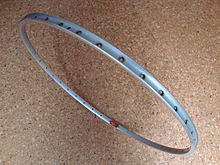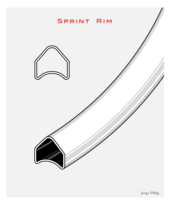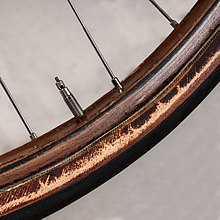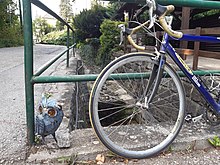Bicycle rim
The bicycle rim is the outer ring-shaped metal, wood or plastic profile of a wheel that holds the tire , the tube and the rim tape . The rim is usually connected to the hub of the bicycle using steel spokes . Particularly aerodynamic rims are also manufactured with molded struts or supported by a continuous disc .
Rim types

A distinction is made between the following rim types:
- Clincher rims or hook rims
- These are drop center rims in all versions. In the pictures, an inwardly directed edge can be seen in the “mouth” of the rim, which is called a “hook”. The tube presses the bead of the jacket against this edge. The bead is held in the rim by the "hook", while radially incorporated wires or high-strength fiber bundles prevent the bead of the jacket from stretching. The English name for this type is clincher .
- Conical Rims or Westwood Rims
- The bead of the tire casing used to contain no wire and was more voluminous than in today's tire types. Conical strip rims were usually wider than today's rims and were made from sheet steel. They did not allow high tire pressures, because the tire bead was less securely anchored in the rim than with today's hooked rims.
- Double wall rims
- Double wall rims have a double rim base that encloses a cavity. Tubular tire rims as well as higher quality clincher tire rims made of steel or aluminum are always hollow section rims in order to be able to achieve sufficient stability with low weight. Only simple clincher rims and the traditional, wide bulge rims are made with a simple U-profile.
- Rims for tubeless tires
- Since 1998, Continental and Rigida have been offering special rims that allow the use of tubeless tires. The rim bed was covered here with a rubber seal inserted in grooves. As a result, tubeless tires in particular were used in mountain biking by adapting largely commercially available wire or folding tire components, in which special rim tapes, screw-in valves and a density emulsion in standard ETRTO- compliant rims are used. Many higher-quality branded rims are currently being marketed as "tubeless-ready" and are prepared ex works for the use of tubeless tires thanks to a special design of the rim base, airtight rim strips and chemical resistance to the density emulsions.
- Tubular rims
- Tubular tire rims are hollow section rims without flanks. They only consist of the base body with a concave surface on which the tubular tire (Switzerland: Collé or Tubolare) is glued with tire cement . Tubular tires allow the highest pressures and are mandatory for track races .
If rim brakes (side pull, center pull brakes, cantilever, V-brakes) are to be used, the side flanks of the rims must be designed as a friction surface for the brake pads. Flap rims were also previously used with link brakes with horseshoe-shaped brackets that pulled the brake pads against the rim bed from below.
Designations
The nominal rim diameter is the diameter of the rim shoulder . The inner edge of the tire should rest on the rim shoulder. The tire designation according to ETRTO consists of the tire width followed by the nominal rim diameter.
The rim shoulder is part of the rim base . The rim bed is usually deepened between the rim shoulders on both sides. The inner edge of the tire is pushed into the recess along a large piece of the rim circumference in order to be able to pull the tire laterally out of the rim mouth at a radially opposite point and then pull this tire edge off the rim.
The rim flank is the side edge of the rim that connects to the rim shoulder and supports the inner edge of the tire laterally.
On the inside of the rim flank of hooked rims there is a molded overhang, which is referred to as the rim flange . The rim flange supports the side bead of the tire wall.
The mouth width is the width of the rim between the rim flanks or rim flanges on both sides.
Spokes and nipples
Usually 36 spokes made of galvanized or stainless steel are used. Rims for tandems or cargo bikes usually have 40 or 48 nipple holes . Sports bikes use 32, 28, 24 down to twelve spokes with pronounced aero rims on the front wheel of racing bikes to reduce weight and in particular the air resistance . Mountain bike rims usually only have 32 spoke holes.
- Perforated rims
- Here the spoke nipples sit directly on the material of the rim base. This is common for rims in a simple U-shape, as these usually have a sufficient wall thickness. Perforated hollow rims without reinforcement are rare.
- Hallmarked rims
- The spokes run from the rim alternately to the right or left flange of the hub . With large wheels and narrow rims, this results in only a slight inclination of the spokes. However, especially with small running wheels, it is necessary to bevel the contact surface of the spoke nipple accordingly in order to avoid one-sided loading of the rim base and the spoke. Traditionally, this is often achieved with a convex rim base in which the nipple holes are alternately placed on the right and left outside the center line. In the made of thin sheet steel Wulstreifenfelgen also hemispherical wells were for receiving the nipple heads often punched . The nipple holes were then made in this recess on the right and left off-center at the correspondingly inclined point. Today, the nipple holes in aluminum rims are pressed into the material at the right angle by inclining the punching tool or flow drill .
- Simply eyelet rims
- With eyelet rims, the nipple holes are reinforced by a fine metal ring (similar to eyelets that are used in textiles or leather). The steel ring prevents the nipple from working into the softer base material of the rim when the force is strong. In addition, the friction between the spoke nipple and the rim is reduced, as is the risk of cracks forming in the rim base. If an eyelet with a slightly larger diameter is used, the conical seating surface of the spoke nipple can align itself at the correct angle without the need for a corresponding lateral inclination of the hole. Similar effects can also be achieved if, instead of the eyelets, washers are used between the nipple and the rim base.
- Double eyelet rims
- In the case of hollow wall rims, instead of flat eyelet rings, higher sleeves ("cups") are often used, which bridge the cavity between the two rim bases. If the sleeves are supported in both openings of the rim bases at the same time through appropriate design of the upper and lower edge, one speaks of double-eyed rims. Deformation and cracking in the rim base due to high spoke tension is excluded here. The inserts also make it easier to insert the spoke nipples when inserting the spokes, which otherwise tend to slide into the hollow space on hollow-wall rims.
material
Metal rims are made from a profile that is bent into the final circular shape and joined at the joint. Today they are mostly made of an aluminum alloy, which, compared to steel, enables a lower weight and a better braking effect of rim brakes. Aluminum light metal profiles are produced in an extrusion process and then bent into shape. The connection at the joint is made either by welding or by pressing connection inserts (e.g. steel pins) into the hollow chambers of the rim profile. The first manufacturer of aluminum rims was Altenburger GmbH & Co. KG in Jestetten in 1936 .
In the high-priced area for racing bicycles or mountain bikes, fiber composite materials are also used, especially plastic reinforced with carbon fibers (CFRP), also known colloquially as carbon or carbon fiber . In combination with rim brakes, however, the braking effect has so far been significantly lower than with aluminum rims. Scandium alloys are also increasingly being used in the high-priced area .
With inexpensive children wheels also running wheels are used, the rim, hub and spokes as a unit from plastic - injection molding is prepared.
A small proportion of wheel rims, actually whole wheels, especially for small children's bikes or bikes with an auxiliary motor, are die-cast from an aluminum alloy like motorcycle rims. Large rims (with a diameter of about 26 inches) often have radially crossed spokes in order to be able to better transmit torque from the - always integrated - hub.
Until the 1960s tubular rims made of wood were mainly used in track cycling . In road cycling , they were occasionally used in professional races until the 1990s.
shape
In addition to the flat sections have proved particularly in cycling , as well as high quality touring bikes and trekking bikes enforced profile rims with drop-shaped cross-section. These are also known as aero or V rims and are significantly stiffer than flat rims. The better drag coefficient (c w ) of these rims mainly plays a role in cycling, as it only becomes noticeable at speeds of around 40 km / h.
The number of spokes can be reduced with stiff hollow-wall rims. In this case, however, the rim base must be made thicker, which is why teardrop profiles are often heavier and therefore have a higher mass moment of inertia .
Sizes
Rim sizes are standardized by the ETRTO , among others . Rims must comply with the specifications of the nominal diameter, the rim flange height and depth, dimensions of the transition radii and some other specified sizes such as the valve hole diameter in order to give the associated tire a secure hold.
For the replacement and the impeller builder, additional information is relevant, such as B. the number of spoke holes and the "relevant rim diameter" (often abbreviated to ERD in manufacturer data sheets , for the English term Effective Rim Diameter ). This refers to the diameter of the circle that is measured over the spoke nipple contact surfaces in the rim base. The spoke length also depends on the distance and pitch circle diameter of the hub flanges, the type of spokes (number of intersections) and the eccentricity of rear wheels with a toothed rim.
Mouth width
As a second parameter in addition to the diameter, bicycle rims have different internal widths. The mouth width is the inside dimension between the rim flanks in the cross section. Mouth widths between 13 and 30.5 mm are common, with fat bikes up to over 70 mm. Not all internal widths are compatible with all tire widths, tire and rim pairings outside of the specifications can cause difficulties during assembly and poor driving and wear behavior, in extreme cases the tire can slip off the rim.
For sporty mountain bikes, a rim width of 17 mm has prevailed, which according to ETRTO is actually only suitable for tires with a width of 37 mm (1.5 inches). In practice, tires up to 60 mm (2.35 inches) wide are often fitted. The combination of narrow rims with tires that are too wide reduces the risk of punctures a little and you save some weight. On the other hand, there are various disadvantages:
- The load on the tire flanks increases as they are bent more strongly directly on the rim edge. Flexing work increases, particularly with mountain bike tires that are driven with low air pressure. As a result, the rubber on the tire flank loosens, the carcass is exposed and the tire develops lateral runout even before the tread has worn off. In the case of more heavily loaded tires, flank breaks occur: lateral bulges and finally cracks through which the tube is pushed.
- The directional stability is reduced when cornering. Tires with air pressure that is too low even tend to break away when cornering.
- The load on the rim flanks increases due to the lateral pull of the tire flank, which increases with the circumference of the tire cross-section. This usually only leads to overloading on the rear wheel of heavily loaded tandems, cargo bikes or touring bikes.
Stiffness
The torsional stiffness of the rim mainly depends on the material used and the geometrical moment of inertia of the rim cross-section, which results from the material thickness and the shape of the rim cross-section. Wide and high rims have a higher geometrical moment of inertia than comparable rims with a flatter or narrower cross-section.
A high degree of rigidity distributes the load on the spokes more evenly and makes the rim less susceptible to unplanned loads. Double wall rims with a high cross-section are particularly torsion-resistant. They usually have an aerodynamically rounded triangular profile, which is referred to as a teardrop or "V" profile. Wheels spoked in this way are characterized by an extremely low spoke breakage rate. A certain disadvantage is that these stiff rims also transmit shocks to the driver better than rims with a flat profile.
Rims with high stiffness are less prone to the development of vertical and lateral runout (an “egg” or an “eight”) and are easier to align (“center”).
The load on the rim is highest near the spoke holes. The spoke holes of aluminum rims are therefore usually reinforced with steel eyelets, which also reduce the friction between the spoke nipple and the rim. For aluminum rims without eyelets, the heads of the spoke nipples should be lightly greased. The manufacturer Campagnolo has reduced the material thickness of some of its rims in the areas between the holes and thus saves 40 grams of weight.
safety
In bicycles with rim brakes, the wear caused by the rubbing of the brake pads on the rim flanks leads to a decrease in the rim wall thickness over time. This becomes dangerous if the rim suddenly breaks open (usually when it heats up quickly when braking hard). The impeller can jam, which can lead to falls. The ADFC therefore recommends using rims with a wear indicator, e.g. B. a turned groove in the rim wall to use. If so much material has been removed that the indicator can no longer be seen, the rims should be replaced. The minimum dimension for the rim wall thickness is 1.1 mm.
There are also rims in which the friction surfaces of the flanks are coated with ceramic, these show almost no wear.
Manufacturer
Bicycle rims are manufactured by a number of companies around the world. In some cases, different bicycle manufacturers have their rims and wheels manufactured by the same manufacturers in China and Southeast Asia. A selection of manufacturers:
- Mavic , French manufacturer of bicycle components
- Miche , Italian manufacturer
- RYDE International , Dutch brand, has taken over the traditional Rigida brand
- DT Swiss , Swiss manufacturer of wheel components, wheels are now also produced in Poland and the USA
- Exal , Belgian manufacturer; taken over by Büchel Group Germany; Manufacturing locations in Belgium and Germany
- Vuelta , German manufacturer; belongs to the Büchel Group
literature
- Michael Gressmann, Franz Beck, Rüdiger Bellersheim: specialist knowledge of bicycle technology , 1st edition. Verlag Europa-Lehrmittel, Haan-Gruiten, 2006, ISBN 3-8085-2291-7
Web links
- Christian Smolik: Running bikes ( Memento from May 19, 2006 in the Internet Archive ) (PDF; 973 kB)
- Rims on Fahrradmonteur.de
Individual evidence
- ↑ sealing milk: converting mountain bike tires to tubeless , bike magazine online v. July 10, 2015
- ↑ Discussion “Schwalbe Procore” , contribution by “mani100” from March 10, 2016, in the IBC (Internet Bike Community) forum, on www.Mtb-News.de
- ↑ a b c Chapter 4: Rims Wheels - www.smolik-velotech.de - Fahrradtechnik Hans Christian Smolik: Developments, reports, publications. Retrieved October 1, 2019 .
- ↑ a b Georg Böger: Technical tips: tires and rims , section "Standard" with consequential damage ", May 2000
- ↑ ADFC technical committee
- ↑ Video tutorial on how to center and check wheels at 1:35, bike workshop. The rim wall thickness can with a calipers are measured when previously placed inside a 2 mm radius and the diameter of which is subtracted from the measured thickness.
- ↑ Company website









